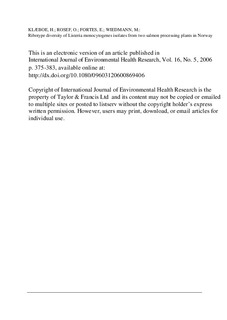| dc.description.abstract | The purpose of this study was to use automated ribotyping procedure to track Listeria monocytogenes transmission in the cold smoked fish production chain and to characterize L. monocytogenes subtypes associated with the salmon processing industry. A total of 104 isolates, which had previously been obtained from a raw fish slaughter and processing plant (plant B) and an adjacent, downstream, salmon smoking operation (plant A), were characterized. These isolates had been obtained through a longitudinal study on Listeria presence, which covered a 31-week period, in both plants. Isolates had been obtained from samples taken from different machinery used throughout the production process. In addition, six isolates obtained from products produced in plant A two years after the initial study were included, so that a total of 110 isolates were characterized. Automated ribotyping was performed using both the restriction enzymes EcoRI and PvuII to increase the discriminatory power. The 110 L. monocytogenes isolates could be divided into 11 EcoRI ribotypes; PvuII ribotype data yielded multiple subtypes within 7 EcoRI ribotypes for a total of 21 subtypes based on both EcoRI and PvuII ribotyping. A total of three EcoRI ribotypes (DUP-1023C, DUP-1045B, and DUP-1053E) were isolated at multiple sampling times from both plants. In addition, one subtype (DUP-1053B) was isolated at multiple sampling times in only plant A, the salmon smoking operation. These data not only support that L. monocytogenes can persist throughout the salmon production system, but also showed that L. monocytogenes may be transmitted between slaughter and smoking operations or may be unique to smoking operations. While the majority of subtypes isolated have been rarely or never linked to human listeriosis cases, some subtypes have previously caused human listeriosis outbreaks and cases. Molecular subtyping thus is critical to identify L. monocytogenes transmission and niches in order to allow design and implementation of control strategies at the appropriate stage of production and in order to reduce the prevalence of L. monocytogenes linked to human disease. | |
